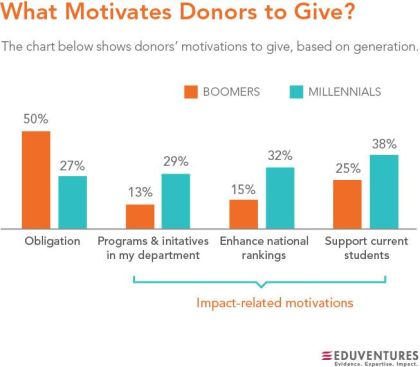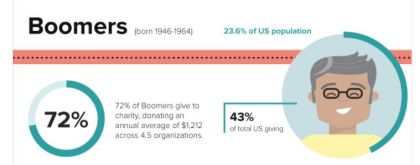Millennials vs. Baby Boomers. The conflict seems to be part of every news headline these days. No doubt you see a difference in how each generation gives to your institution as well.
It’s true that Millennials are more likely to give online, and Baby Boomers and seniors are more likely to give through direct mail. In many ways, technology has created a deeper dividing line between generations.
There are so many more factors at play, however — factors that make a big difference in how advancement offices should approach donor engagement.
- Our longer lifespans are allowing more generations to cross paths.
- Millennials and the generation that follows — often called Generation Z or Centennials — have more student debt than previous generations.
- The value of a college education has changed in many ways, and is under more scrutiny.
These factors and others mean that motivation is different between the generations as well. According to research by Eduventures, 50% of Baby Boomers give out of a sense of obligation, while only 27% of Millennials are motivated by loyalty. More Millennials are motivated by the impact of their gifts than by obligation.

Source: Eduventures’ Alumni Pulse Dataset
The changing landscape of alumni giving is showing up in overall participation rates, as well. Today less than 10% of undergraduate alumni give back to their alma maters — a 5% drop in the last decade alone.
The Center for Generational Kinetics gives this breakdown of the five generations alive today, though many sources may disagree on the exact years:
- Gen Z (aka Centennials): Born 1996 and later
- Millennials: Born 1977 to 1995
- Generation X: Born 1965 to 1976
- Baby Boomers: Born 1946 to 1964
- Silent Generation: Born 1945 and before
Though the generations differ in how they give and who they give to, they have one important thing in common: They still believe in the importance of giving.
So before you write off Millennial donors for good, read on to discover a few small changes you can make to create a big impact on your fundraising results.
Understand and Adjust to the Difference Between Loyalty and Impact
So you know, now that the Baby Boomer generation is much more motivated by loyalty (sense of obligation), while Millennials consider more the impact of their giving. It makes sense that each group requires a different approach to stir their motivation.
For Baby Boomers, emphasize your recurring giving programs. Make it easy for them to act on their sense of loyalty with automated monthly giving. Especially prioritize donors who have given regularly, and invite them into your exclusive group of monthly givers.
Since Millennials need to know what impact they are making with their donations, give them targeted options. In your preliminary research, plan to discover what each prospect might care about — a college, program or group, for example — and present options to them that may hit home. Make them feel like they are making a direct impact on something they believe in.
If your organization has a strong need for unrestricted funds, fear not. Explain to Millennial prospects exactly how unrestricted funds benefit the institution. Appeal to their emotions.
Improve Transparency to Attract Millennial Givers
Transparency has become more important for every generation as more stories of misused funds emerge every day. For Millennials, though, transparency holds an even more important position in the fundraising process.
Make information readily available on your foundation or advancement office website and forms about exactly where donations will go. Share dollar numbers candidly and show proof of how gifts are being used. Photos, videos, student quotes and motivational stories go far to give Millennial constituents the feeling of trust and connection.
Remember this: Research shows that Millennials are slower to trust than other generations. Give them options for where their money should go, and be transparent about how it’s being spent.
There’s a direct payoff to transparency in the amount and frequency of gifts, but there’s another benefit many development teams overlook. That’s the benefit of Millennials’ constant connectivity. This generation is the first to be networked together 24/7 — and spreading the word about what they’re doing is part of their everyday reality. Peer-to-peer fundraising is a powerful force for this group.
According to the Millennial Impact Report,
- 64% of Millennials raise money for walk/run/cycling events.
- 46% ask people to give donations instead of buying them birthday gifts.
- 70% are willing to fundraise for an organization they’re passionate about.
To sum it up, the more Millennials you can engage with, the more they will spread the word to others in their network, potentially creating a donation snowball effect.
Choose the Right Medium to Reach the Right People
The medium you use to reach constituents matters more than ever. Phone, email, text message, social media, snail mail — consider who you’re reaching out to before you choose your channel.
Here are some general generational preferences that prove accurate more often than not:
- Millennials are active on their smartphones. They respond best to text messages and social media.
- Gen Xers are also likely to answer text messages, and more likely than Millennials to answer phone calls. They also check their email more frequently than Millennials, and try to stay up-to-date on social media.
- Baby Boomers use technology across the board. They’re as likely to pick up the phone as they are to check their email, answer text messages and read social media posts.
- The Greatest Generation prefer phone calls and direct mail. Email is uncertain with this group, and text messaging and social media are virtually off the table.
Rather than going for a one-size-fits-all approach, consider who you’re talking to before you reach out to a prospect. Choose the medium that they are most likely to respond to, and you’ll get better results every time.
And don’t be afraid to ask! If you reach a constituent, ask them if that method is the best way to reach them, or if they prefer another communication channel. It’s a great opportunity to learn about your prospects while making a personal connection.
Check out this infographic from MobileCause for even more information about demographic differences:

Different Generations Have Different Preferences
Segmenting constituents by age isn’t a foolproof approach, but it can certainly give you a leg up on your annual giving goals.
Providing the right content, context and opportunities to your prospects becomes much easier when you consider the world they grew up in and how they are likely to be motivated today. As each subsequent generation is born and goes through the educational system, and new technology and trends enter the picture, these factors will change. It’s our job as advancement professionals to keep up with these changes to better understand the people we engage with.
